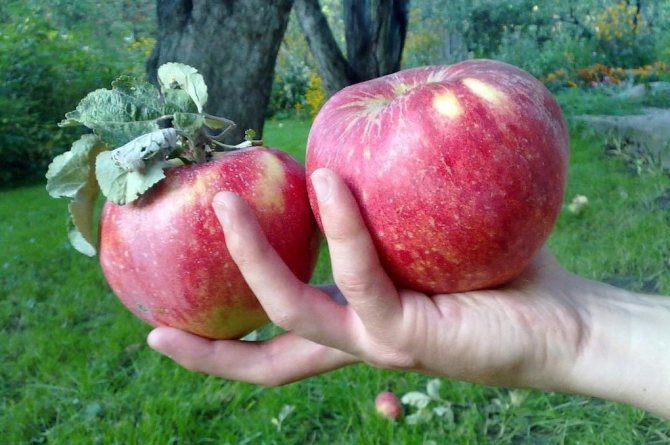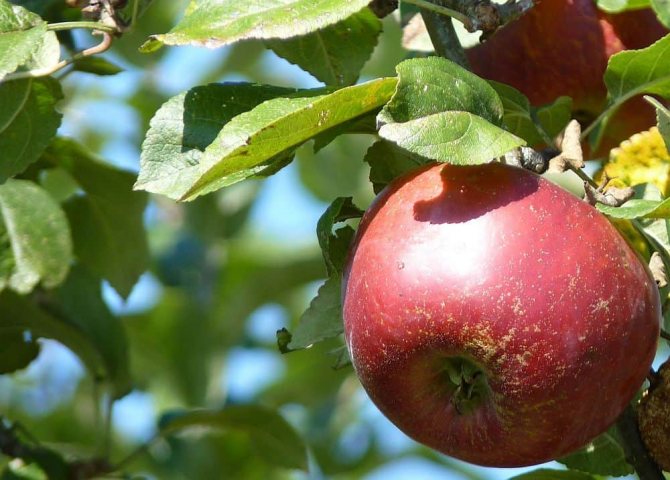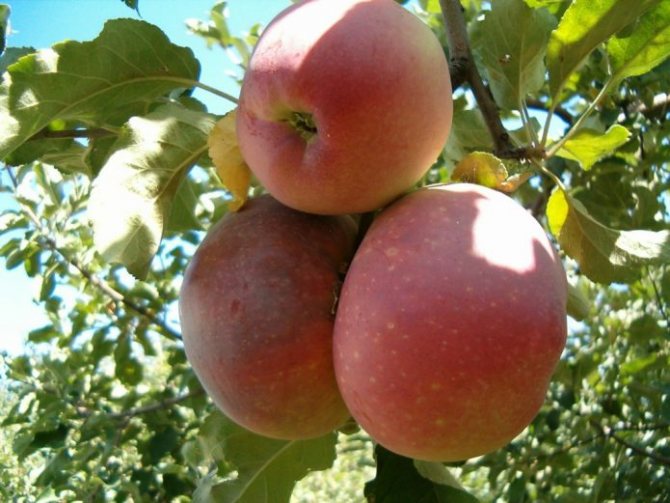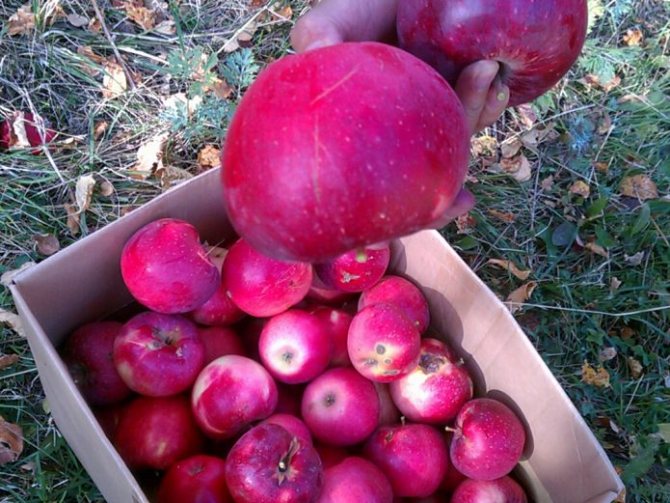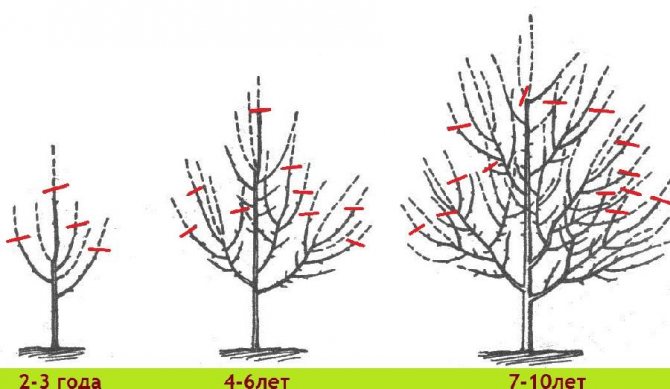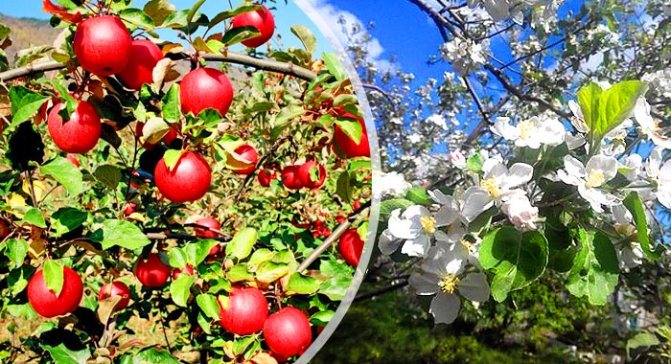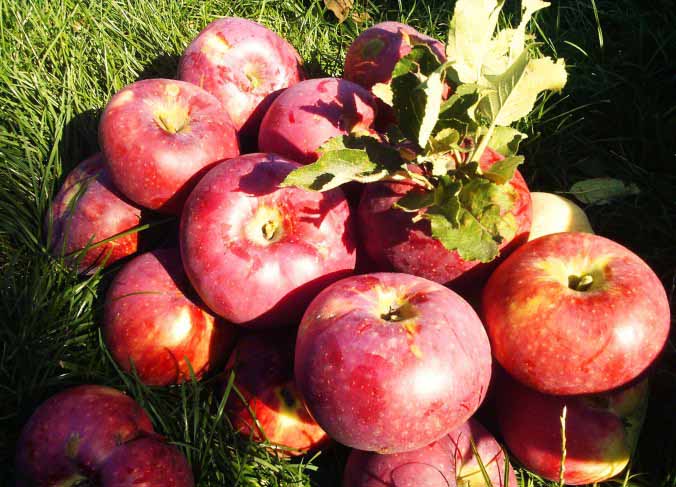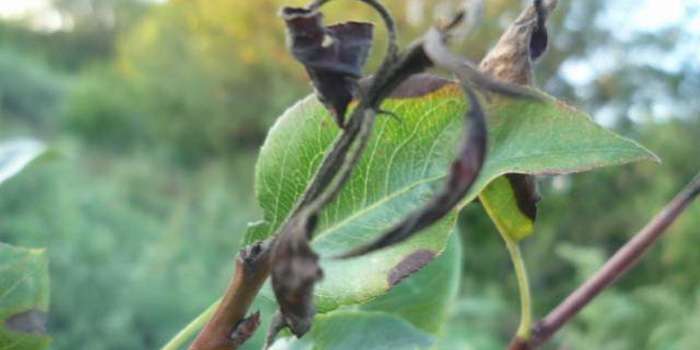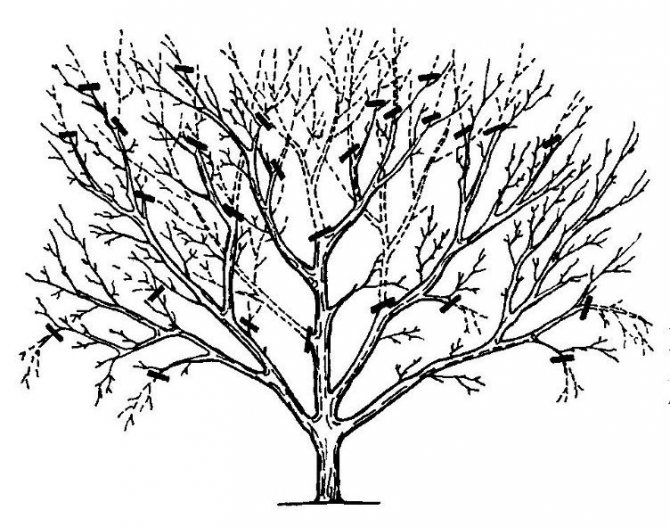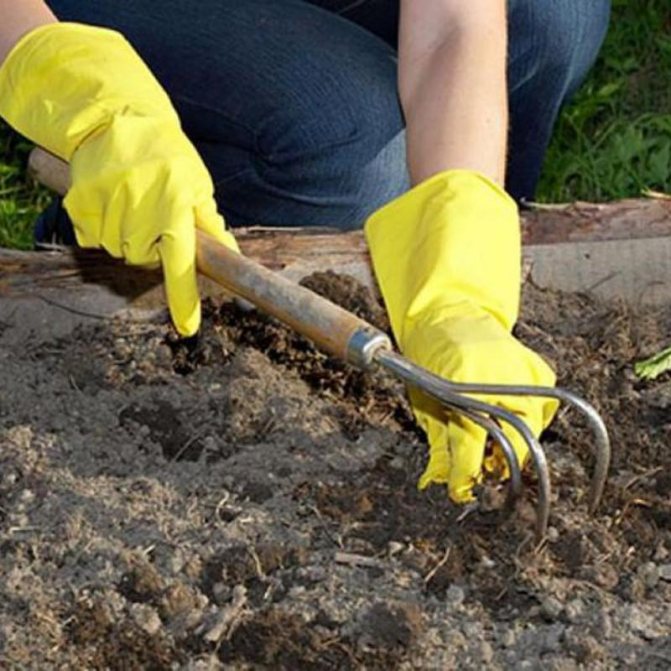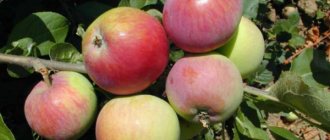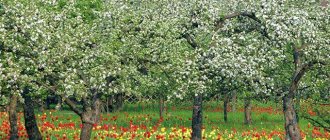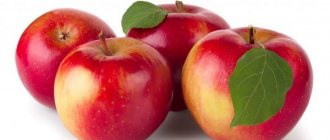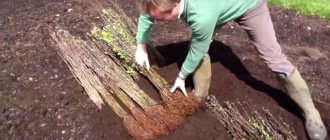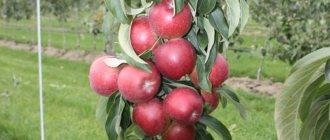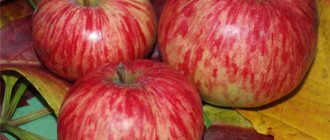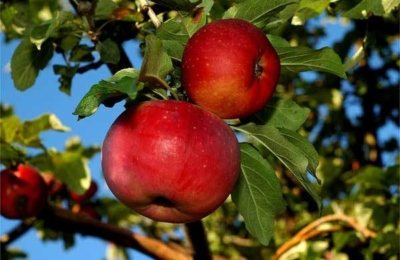
One of the world's oldest varieties is considered to be the Aport apple tree, which probably began its pedigree on the territory of Ukraine, and then became widespread in Europe, the USA and Canada.
Gradually, based on the original variety, varieties were developed that were adapted to local conditions.
This is how Aport Dubrovsky, Pushkinsky, Kubansky, Bely and a number of others appeared. But the first place among them is occupied by the Almaty Aport, which has become widespread in Kazakhstan.
Description of the apple tree


Aport is a late-ripening variety that gives its first harvest 4 to 5 years after planting. Trees grow of medium height, with a powerful and spreading crown.
The leaves grow at the ends of the branches, are dark green in color, slightly bent.
During flowering, the apple tree becomes covered with white flowers.... Apples are distinguished by their large size and juicy sweet and sour taste.
Suitable for fresh consumption, for making preserves, jams, dried fruits, and wine.
Breeding history
The first mentions of the Aport variety date back to 1175. One of the monastic chronicles indicates that the variety was brought to the Kingdom of Poland from the Ottoman Empire. In addition, it is documented that in the XII century this variety grew on the territory of Ukraine. Therefore, it is likely that this variety originally had Ukrainian roots.
In Russia, the variety was first described in 1779 by the breeder Bolotov... Since the beginning of the 19th century, Aport began to actively spread in Europe - Germany (where it was named "Russian Emperor Alexander"), Belgium, France, England. Then the variety was introduced to the USA and Canada.
The original variety was used for breeding in new regions - it was grafted onto local varieties or wild apples, as a result, new varieties of the variety appeared. Among them are Almaty, Kuban, Bely and others.
Varieties of varieties
Aport has several clone varieties. They have approximately the same characteristics, but some differences still appear.
Almaty
This variety was bred by Kazakh breeders. It is adapted to growth and fruiting in mountainous conditions. The Almaty variety of apple trees has large fruits that can survive until next summer.
Blood red
The apple tree got its name for its bright red fruits. The weight of the fruit is 240-260 grams, its pulp is creamy with a spicy taste. The fruits ripen in late September or early October.
Alexander
This variety is almost a complete copy of the Aport. The difference manifests itself in the fact that light stripes are more noticeable on Alexander. In addition, its flesh is more yellow.
The most common Aport hybrids are:
- Aport Alexander, which is almost similar to the parent variety. The difference is the yellow color of the pulp and more pronounced mottling;
- Aport Almaty is the largest-fruited variety. Its apples often reach a mass of 900 g. Also, this hybrid has a winter hardiness and a shelf life of fruits slightly higher than that of Aport itself;
- The blood-red aport differs from the main species in the color of the fruits and pulp. The blush color is bright red. The pulp has a pink tint. The taste also differs from that of the Aport in the presence of spicy notes.
Features of the
A distinctive feature of this variety is the size of the fruits, the average weight of which is 300 g., however, it is not uncommon for a tree to yield a harvest of half a kilogram of apples. It is a high-yielding variety suitable for moderate winter climates.
The variety is not resistant to such common diseases as scab, moniliosis. Therefore, for successful growth, it is necessary to carry out preventive measures against diseases and pests. The fruits tolerate transportation well and can be stored for quite a long time if the storage conditions are observed.
Aport belongs to the winter varieties of apples, as well as Antonovka.
Tree height
Aport belongs to medium-sized varieties, as it grows up to 5-6 m in height.
Crown width
Crohn grows powerful, branched, in width reaches 10-12 m.
Yield
The aport has rather high yields - a mature tree at the peak of fruiting gives about 150 kg.
Tasting assessment
The fruit of the Aport variety tastes sweet and sour, with a wine aftertaste... Tasting score 4.6-5.0 points.
Frost resistance


The aport does not tolerate frost very well, therefore it is recommended for cultivation in regions with moderate winter temperatures.
However, it should be noted that in the process of spreading the variety, varieties were bred.
These apple varieties were better adapted to the conditions of frosty winters.
Self-fertility
This variety can be grown without pollinators, but this will result in lower yields. Therefore, if possible, it is better to plant a suitable pollinator in the neighborhood.
The timing of flowering and harvesting apples
This variety blooms in June with delicate white flowers. Aport belongs to late varieties - Harvesting begins in late September or early October.
Pollination
Apple trees of the following varieties are best suited as pollinators: Shield, Memory of Esaul, Prikubanskoe.
Dimensions (edit)
The fruits grow very large, weighing 270 - 300 g, although fruits weighing up to 600 g are not uncommon. The shape of the fruit is round, slightly flattened... The skin is of medium density, slightly oily, red-green in color with yellow spots. The pulp is white, medium density, crumbly.
The beginning of fruiting
The aport is distinguished by a fairly rapid onset of fruiting - most often the first crop appears 4 - 5 years after planting the seedling. However, the variety bears fruit periodically - once every two years.
We also recommend that you read the materials about other interesting varieties - Berkutovskoe, Grushovka, Candy, etc.
Yield
Fruiting occurs at a one-year growth rate and occurs only for 7-8 years... Further fruiting lasts for 40 years.
The crop, according to the literature, can be harvested annually and in large quantities, but more often it happens after a year. The yield is large, on average, one tree gives up to 150 kg. Shelf life of such apples from two to four months.
High-yielding varieties are also considered: Shtrifel, Aloe Rannee, Nastenka, Kuibyshevsky and Antonovka ordinary.
NOTE: Those Aport apples that were grown in the mountains can be stored longer.
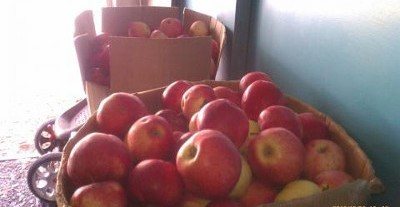

In winter, apples should be stored in wooden containers or racks, possibly also in cardboard and wooden boxes.
The optimum temperature is 0 ° C. It is advisable that the fruits are sized by size.
Growing region
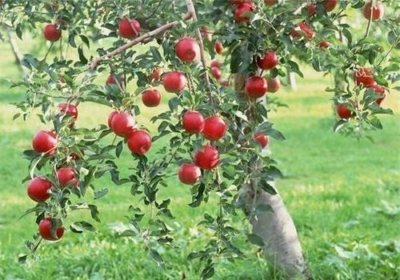

Due to its low frost resistance, Aport is best suited for cultivation in southern regions with a warm climate.
Even in the middle lane, Aport may not survive the winter - there are many cases when trees could not withstand frost and died.
In the middle lane it can be grown, but with some risk. Sometimes grafting of Aport to more frost-resistant varieties helps.
Expert opinion
Klimkina Elena Vladislavovna
Florist, businessman.Organized my business on a suburban land plot
For the Urals and Siberia, the stale form of the Aport is used - the crown of the tree is formed in such a way that the main branches are covered with snow in winter. Thanks to this, the branches are protected from the influence of low temperatures.
The formation takes place as follows:
- When planting, the seedling is placed at an angle of 45 °.
- Then, when the tree is rooted, the central branch is removed, and the skeletal branches are attached with special hooks to the soil.
Characteristic
The Aport variety can be called autumn, but its subspecies can change the timing of flowering and ripening. Fruits are always large in size, which is a special feature. They lie for quite a long time under the right conditions, they are easily transported over long distances. The tree itself is of medium height, spreading and fruitful.
Advantages and disadvantages
The variety has a number of positive properties. But he also has disadvantages, and many of them are quite tangible. Therefore, when landing, it is worth considering all the features. The advantages are the amazing taste and appearance of fruits, the possibility of their long-term storage and transportation. The size is no less impressive: their weight can reach 900 grams.
But among the shortcomings, it is worth noting a weak immunity, which is the cause of the onset of fungal diseases. The aport is affected by scab and powdery mildew, and quite often. Trees can get sick with fruit rot. At the same time, preventive spring spraying will not be enough, during the season it will be necessary to inspect the apple tree for damage. It is worth noting that the resistance to low temperatures is quite average. Therefore, Aport prefers to grow only in favorable conditions and can freeze slightly.


Apple fruits.
Apple variety and classification
It is called the Sortotype because, on the basis of the Aport, a lot of subspecies with improved properties have been derived. They are distinguished by zoning, quantitative and qualitative indicators of the yield, as well as the ability to adapt to climate change. So, there is, for example, Ukrainian Aport, which is most common in Ukraine, or Almaty, with a corresponding place of residence.
Zoning varieties
The frost resistance of the apple tree is average, and if to tell the truth, even weak. Therefore, the original variety prefers to grow most of all in favorable, preferably southern regions. In the middle lane, Aport can grow, but it is at risk and can freeze slightly.
Tree and crown morphology
The apple tree is considered medium-sized, its maximum height is 7 meters. The crown is quite powerful and spreading, but not too thick. The branches are small, covered with sparse twigs. The leaves are emerald, rounded, slightly flattened.
Fruits are large, even 500 g in size, but usually they are medium, about 300 grams each. The taste is delicate, sweet and sour, the aftertaste is pleasant, wine. The exact figure for the tasting score is from 4.6 to 5 points.
Yield
The yield indicator, which is officially recorded, is about 150 kg from an adult tree. But this is an average figure. However, there are subspecies that bear fruit twice per season. And there are those that often have a fruiting frequency.


An adult apple tree.
Winter hardiness and disease resistance
Low temperature resistance is rather weak. This means that in cold regions, the wintering of the apple tree will be quite cold. It happened that even adult apple trees were damaged so much that they could not recover. To grow the variety in cold climates, it is grafted onto frost-resistant rootstocks.
The issue of disease resistance is also quite complex. The aport suffers from rot, powdery mildew and scab. Therefore, it will be necessary to monitor the condition of the plant throughout the season. And this is in addition to the mandatory preventive spraying.
Tree lifespan
Fruiting period - up to 40 years, from the fifth year after planting. After this period, the apple tree can simply live in the garden for a long time.But if you carry out anti-aging pruning in a timely manner, then this figure can increase significantly.
Testimonials
- Natalia, teacher: “I have been familiar with this variety for a long time. When the harvest is large, it is possible to prepare jam and compotes, we also make juice. And relatives also make wine quite tasty from it. "
- Mikhail, engineer: “Aport has a rich aroma and excellent taste. The only thing that takes up a lot of space, since the crown is very spreading. I had to replant the neighboring trees due to lack of space. "
- Inga, musician: “We got two trees from my grandmother, so they are over 20 years old. They do not bear fruit every year, but the harvests are still quite abundant. We do not forget about top dressing and prevention against scab, otherwise they will hurt and bear poor fruit. "
- Olga, doctor: “We were lucky enough to get a sapling of the Almaty Aport - they grafted it into the wild, as we were not sure that the tree would take root in our suburbs. A few years later, the apple tree made me happy with the first harvest - the apples were very juicy and aromatic, they lay for quite a long time ”.
- Nikolay, pensioner: “The first Aport sapling did not survive the winter, so we were more careful with the second one - they carefully covered it for the winter, applied fertilizers in spring and autumn. As a result, the tree began to bear fruit in the 7th year, the harvest pleased both in size and taste. I know that the variety is quite capricious, so you have to work a lot with it. "
Varieties and their photos
Due to its fairly wide distribution in different regions, on the basis of the Aport, several varieties were bred with some differences.
Alexander
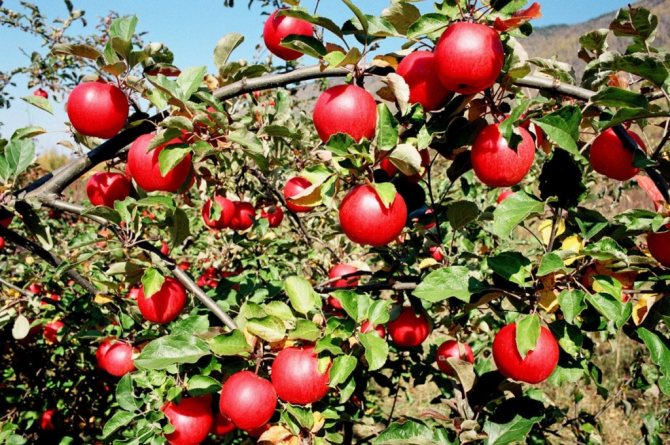

In fact, this is the ancestor of the Aport variety, which got its name from Germany and then England.
Blood red


The fruits are blood-red in color, the flesh is medium-grained, with a light spicy taste. The apple tree bears fruit every four years., since after a year with a large harvest on the apple tree, it is necessary to cut out all the fruit buds.
Thanks to this, in the first year the apple tree rests, in the second year it gives several dozen apples, in the third year the harvest reaches 60 kg, and in the fourth year it brings the richest harvest. Then the cycle repeats again.
We offer you to watch a video about the apple tree Blood-red aport:
Almaty
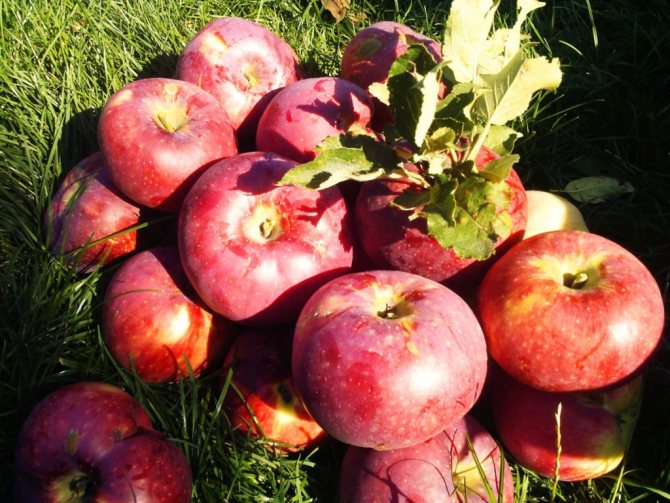

It was bred in Kazakhstan, where it quickly became a kind of pride of the country. The fruits of this variety are striking in their size, as they reach a weight of 900 g. At the same time, trees growing in the mountains, at an altitude of 900 to 1200 m above sea level, give the best harvest. Almaty Aport is stored for a long time - it can lie until May.
Dubrovsky
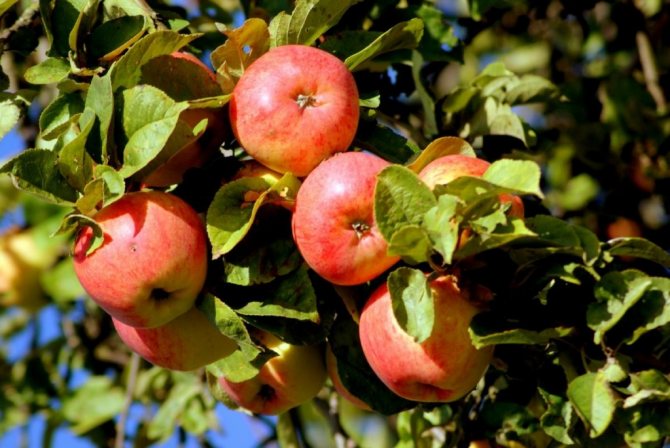

It is a semi-dwarf rootstock (up to 2.5 m high), characterized by high winter hardiness and good adaptive qualities.
Pushkin
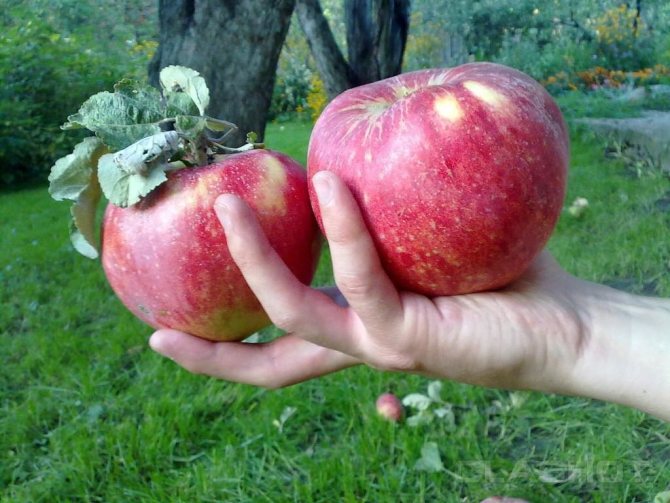

The variety is zoned for cultivation in the Moscow region, as it tolerates frost well. The tree begins to bear fruit at 5 - 6 years. Apples grow large, weighing up to 250 g, with a spicy taste and strong aroma.
Kuban
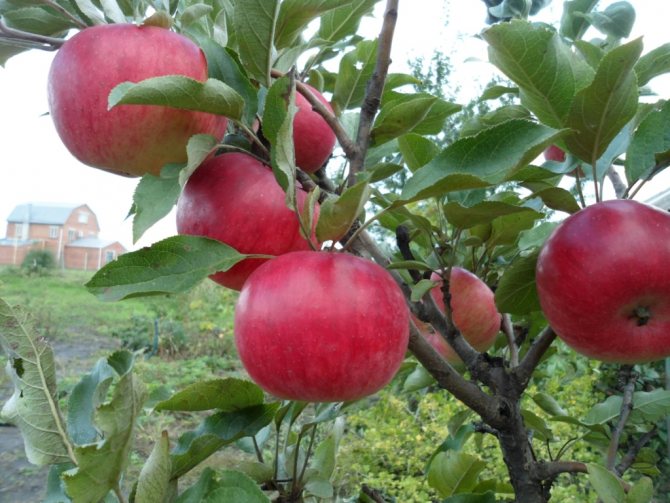

It is best suited for growing on low-growing rootstocks, has good immunity against most diseases, and is resistant to frost. Apples ripen in mid-September, but not stored for long - no more than 2 months.
White


As the name suggests, the fruits of this variety differ in color from the original variety. In terms of other parameters, the variety is similar to Aport Dubrovsky.
Slate form


Suitable for growing in areas with harsh winters, for example, in the Urals or Siberia.
Suitable region and climate
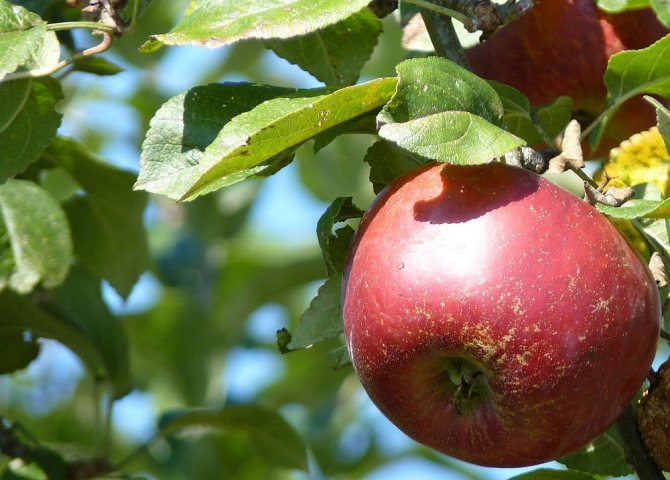

The apple variety Aport is intended for regions with not too cool winter temperatures. This apple tree does not tolerate severe frosts, therefore it is not suitable for cultivation in the north. Note, however, that some clones, cultivars Aporta have quite high frost resistance.
And since the variety is not resistant to cold weather, in our country it is grown only in the south, as well as in the Black Earth Region, in some areas of the middle belt - where the climate is milder. In Ukraine, the Aport variety is widespread throughout almost the entire territory.
Growing rules
A young tree of the Aport variety is watered 1 or 2 times a week... It is especially important to monitor the soil condition during hot weather. More frequent watering may be required. The entire perimeter of the trunk circle should be watered, and not just the area near the trunk. After watering, it is imperative to loosen it so that oxygen flows well to the roots.
For additional preservation of moisture in the ground, it is recommended to mulch the apple tree with sawdust, humus or rotted manure with a thickness of at least 5 cm. Pruning is also important for this variety, since they pursue several goals - sanitary, rejuvenating and forming.


The first pruning is done in the 2nd or 3rd year after planting in the spring, before the onset of buds and sap flow. Cut branches growing inside the crown, as well as old and diseased branches.
If the tree is sick in the middle of the season, sanitization is carried out as soon as possible, without waiting for spring. During formative pruning, branches are removed that intersect or rub against each other.
Generally the crown of the Aport is not very dense, so it does not require strong pruning.
When to plant and how to choose?
Since Aport does not tolerate frost well, it is best to plant a young tree in the spring, starting in mid-April. So over the summer, the seedling will have time to take root, get stronger and gain strength for a successful wintering.
A seedling should be chosen no older than 2 years - it should have 2 - 3 additional branches growing at an angle of 50 - 90 °, with well-developed roots.
For 1 - 2 days before planting, it is worth placing the seedling in the water, and just before planting for 1 - 2 hours, you can put the seedling in a solution with a diluted growth stimulant (for example, "Kornevin" or "Heteroauxin" will do). This will increase the survival rate of the young tree.
Site selection and preparation, distance to other trees
The best soil is drained loam. However, cultivation on other types of soils is allowed, subject to preliminary preparation of the site - first, a hole of a meter diameter is dug out and a mixture of sand, compost and peat chips is poured into it. Since the apple tree does not like excessively wet soil, the planting site is chosen on a hill.
- If the place is level, you can create an artificial hill around which you can dig drainage grooves to drain excess moisture. Aport, like other apple trees, loves a well-lit, wind-protected place. You need to prepare the hole at least a week before planting, but better in the fall. The pit should be 1 m deep and wide.
- The removed soil is mixed with a bucket of sand, a bucket of peat, 800 g of wood ash. It is also worth adding mineral fertilizers - superphosphate, potassium sulfate, potassium salt are suitable.
- Next, the seedling is placed in a hole, the roots are carefully distributed and gradually covered with soil, periodically shaking so that there are no voids around the roots. The root collar should remain 8-10 cm above the ground.
- At the end, the seedling should be watered abundantly with water (about two buckets) and mulched with a mixture of humus and peat.
Since the crown of the Aport grows very wide and spreading, it is better to leave the distance to other trees, fences or outbuildings at least 5 meters.
The need for a transplant
The aport does not require a transplant, but if the need arose, it should be done in early spring before the leaves appear. The tree is dug up with a large clod of earth (the diameter of the clod should be approximately equal to the diameter of the crown) and carefully dragged on a piece of cloth to a new location.
The pit should be prepared in advance according to the same principle as for the initial planting of the seedling - that is, apply a fertile layer and fertilizers.
Top dressing
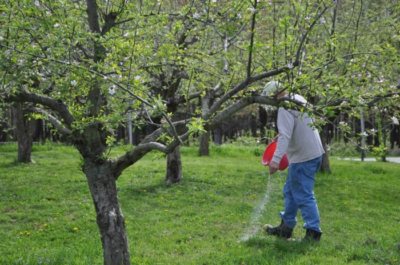

The first feeding of the Aport should be done in the 3rd year after planting.:
- First, in the fall, organic fertilizers are applied (compost, rotted manure), which are distributed around the tree and slightly deepened during loosening.
- Then urea can be added in early spring - if the soil is sufficiently moist, dry urea (500 - 600 g) can be used.
- If the weather is dry, you can prepare a urea solution at the rate of 30-50 g of fertilizer per 10 liters of water.
Before flowering and during fruit setting, phosphorus-potassium fertilizers are applied. For these purposes, slurry (0.5 buckets), 1.5 - 2 liters of liquid chicken manure or 100 g of superphosphate together with 60 - 70 g of potassium are suitable. Each of these fertilizers is dissolved in 10 liters of water.
Expert opinion
Klimkina Elena Vladislavovna
Florist, businessman. Organized my business on a suburban land plot
In the fall, feeding is also carried out using a mixture of potassium (1 tbsp. L.), Double superphosphate (2 tbsp. L.) And calcium (1 tbsp. L.). This mixture is diluted in 10 liters of water and root feeding is performed. Top dressing will allow the tree to get stronger and stock up on strength for wintering.
Care
Watering
Young apple trees are watered once every 14 days. Consumption - 30 liters per 1 tree. In the heat, the frequency of the procedure increases, the guideline is the rate of soil drying in the near-trunk circle.
For mature trees, 4-5 abundant watering is carried out per season:
- in the spring, after waking up;
- during the flowering period;
- when forming ovaries;
- in the process of ripening the crop;
- the last watering - at the moment of leaf fall, before frost.
Top dressing
The first three years are not fed. The apple tree has enough nutrients embedded in the soil during planting.
Then the procedure is carried out twice a season: in the spring, nitrogen fertilizers prevail, in the fall - they focus on the potassium-phosphate complex.
Please note: it is not recommended to exceed the dosage indicated in the instructions for the drugs. A large amount of nitrogen will provoke a powerful growth of green mass at the expense of yield.
Pruning and shaping the crown
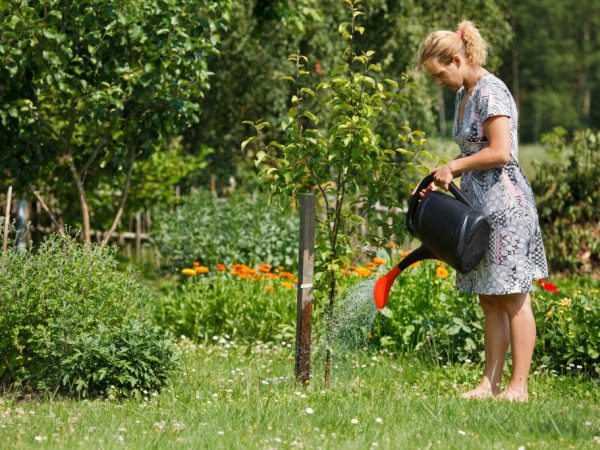

Young trees need frequent watering
Pruning is carried out for 3-4 years. It is better to do it in the spring, when broken and frozen segments are visible.
First of all, shoots are removed that grow downward and inward, thickening the crown, running parallel to the skeletal branches or intersecting with them.
In adult trees, crown formation takes place according to a certain pattern: old and diseased branches are gradually cut off (they are replaced with younger and stronger ones).
An important rule is that you cannot cut off more than one large branch or 2-3 medium thickness at a time.
Autumn pruning is formative in nature. The main branches are shortened by 1/3, the height is adjusted depending on the variety or subspecies.
Diseases and pests
Aport, unfortunately, is not very resistant to diseases.:
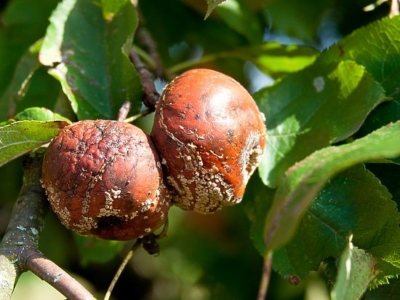

- In particular may be affected by scab. For its prevention, the tree is treated with a solution of urea (700 g per 10 l of water) and copper sulfate (50 g per 10 l of water).
You can also use a solution based on wood ash - 1 glass of ash is poured with boiling water and then dissolved in 10 liters of water.If the tree is still sick with scab, you can use urea and copper sulfate in a higher concentration. Also, for spraying before flowering, a solution of the "Hom" preparation (40 g per 10 liters of water) is suitable - it will take from 2 to 5 liters per tree.
- One more the danger to Aport is the tinder funguswho loves to settle on trees of this variety. The mushroom takes nutrients from the apple tree, so while it is soft, it should be cut off as soon as possible with a regular garden knife.
If the mushroom has already hardened, it can only be removed with an ax. This should be done carefully, taking care not to damage the wood. The damaged area is treated with a solution of copper sulfate (100 g per 10 l of water) and oil paint is applied. - Often Aport infects a disease called moniliosis, or fruit rot... Treatment with colloidal sulfur (100 g per 10 L of water) or a suspension of malofos (50 or 100 g per 10 L of water) can successfully fight this disease.
- Green aphids and moths also love Aport... In the fight against green aphids, a 0.3% solution of entobacterin will help. They use karbofos and chlorophos from the moth. For pest control, one treatment is not enough - it is necessary to carry out 5 - 7 sprays per season with a frequency of once every two weeks. The last treatment is done 20 days before harvesting.
The aport, thanks to its long history, is known in many parts of the world. Large fruits, rich aroma and taste attract many apple lovers. A tall, spreading tree is capable of producing crops up to 40 years, the quality of which, subject to the rules of care, will be quite stable. However, the peculiarities of the variety make it attractive for cultivation only in warm climatic zones, where there is no threat of severe frosts.
Reproduction and planting
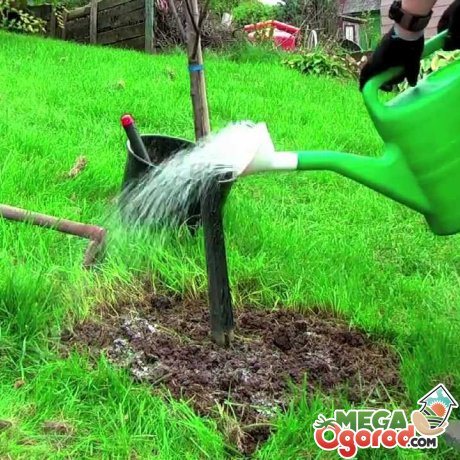

Apple seedlings Aport are obtained by planting seedlings. At the age of two, they are planted in a permanent place. It should be sunny, protected from cold winds. The depth of the groundwater must be at least one and a half meters. If they come closer, drainage from broken bricks and stones is laid on the bottom of the pit, and the tree is slightly raised above ground level.
Before buying, carefully examine the root system of the seedling.
The root collar should be well defined, the trunk should be straight, the roots intact. Otherwise, the seedlings will not take root or die in the first winter. The length of the roots must be at least 40 cm. The trunk is cut at a height of 80 cm. If the roots are less than 40 cm, the trunk is cut even lower.
The roots of the apple tree Aport are soaked in water for a day before planting. To stimulate the active formation of new roots, solutions of Heteroauxin and Kornevin are used. The pit for planting an apple tree Aport is prepared six months before planting. The diameter and the depth of the pit is 1 m. The removed soil is mixed with humus, compost, sand, wood ash and mineral fertilizers are added.
But it happens that the decision to plant a tree comes unexpectedly, then:
- It is advisable that at least 3 weeks pass from preparing the pit to planting the tree. This is necessary in order for the prepared soil to settle.
- It is better to plant seedlings after purchase. But sometimes you have to store them for several days in a prikop.
- They dig a trench, lay seedlings and lightly sprinkle them with earth. Moisten the soil.
- Before planting, a clay chatter is prepared, into which the roots of the tree are dipped before planting. After the procedure, they should dry for about 20 minutes.
- A mound of harvested earth is poured at the bottom of the pit. A peg is placed to tie up a tree.
- Carefully place a seedling in the pit, spreading the roots in different directions along the mound.
- Sprinkle them with earth, pouring water on each ball and compacting it. They look carefully so that the root collar does not fall under the ground. This can lead to the development of fungal diseases.
- A roller is formed along the perimeter of the trunk circle, which will not let water outside of it. Watering the tree. The trunk circle is mulched with a layer of peat, straw or mown grass at least 5 cm thick.
Not all gardeners will agree to grow a large tree in the garden that bears fruit every four years. For many, it is enough to pin several branches into the crown of any frost-resistant variety of late ripening.


